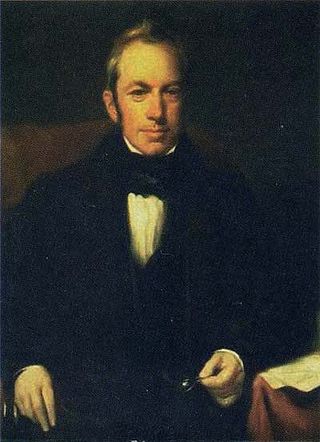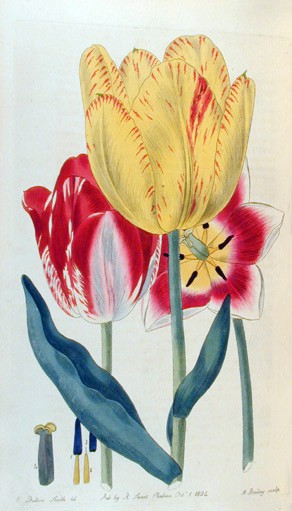
Thomas Phillips RA was a leading English portrait and subject painter. He painted many of the great men of the day including scientists, artists, writers, poets and explorers.

Robert Brown was a Scottish botanist and paleobotanist who made important contributions to botany largely through his pioneering use of the microscope. His contributions include one of the earliest detailed descriptions of the cell nucleus and cytoplasmic streaming; the observation of Brownian motion; early work on plant pollination and fertilisation, including being the first to recognise the fundamental difference between gymnosperms and angiosperms; and some of the earliest studies in palynology. He also made numerous contributions to plant taxonomy, notably erecting a number of plant families that are still accepted today; and numerous Australian plant genera and species, the fruit of his exploration of that continent with Matthew Flinders.

George Bentham was an English botanist, described by the weed botanist Duane Isely as "the premier systematic botanist of the nineteenth century". Born into a distinguished family, he initially studied law, but had a fascination with botany from an early age, which he soon pursued, becoming president of the Linnaean Society in 1861, and a fellow of the Royal Society in 1862. He was the author of a number of important botanical works, particularly flora. He is best known for his taxonomic classification of plants in collaboration with Joseph Dalton Hooker, his Genera Plantarum (1862–1883). He died in London in 1884.

Sir William Jackson Hooker was an English botanist and botanical illustrator, who became the first director of Kew when in 1841 it was recommended to be placed under state ownership as a botanic garden. At Kew he founded the Herbarium and enlarged the gardens and arboretum. The standard author abbreviation Hook. is used to indicate this person as the author when citing a botanical name.

Sir Edwin Henry Landseer was an English painter and sculptor, well known for his paintings of animals – particularly horses, dogs, and stags. However, his best-known works are the lion sculptures at the base of Nelson's Column in Trafalgar Square.

John Raphael Smith was a British painter and mezzotinter. He was the son of Thomas Smith of Derby, the landscape painter, and father of John Rubens Smith, a painter who emigrated to the United States.

Benjamin Marshall was an English sporting and animal painter. He was a follower of George Stubbs and studied under Lemuel Abbott for three years.

Robert Sweet was an English botanist, horticulturist and ornithologist.
Sir William Charles Ross was an English portrait and portrait miniature painter of Scottish descent; early in his career, he was known for historical paintings. He became a member of the Royal Academy in 1842.

John Jabez Edwin Paisley Mayall was an English photographer who in 1860 took the first carte-de-visite photographs of Queen Victoria. He is most well known for his 1875 portrait of Karl Marx.

Thomas Herbert Maguire was an English artist and engraver, noted for his portraits of prominent figures.
John Chamberlaine was an antiquary and acted as keeper of George III's drawings, coins and medals from 1791 until his death in 1812. He published prints of drawings in the Royal Collection by Holbein, Leonardo, Annibale Carracci and others, for which Francesco Bartolozzi (1728–1815) the engraver and etcher, was commissioned as a printmaker.

Edward Rooker was an English engraver, draughtsman and actor.

James Digman Wingfield (1800–1872) was a British painter, known mainly for historical subjects, as well as for landscapes, portraits, and interiors.

William Essex, was an English enamel-painter. He was the chief mid-nineteenth-century exponent of enamel painting, an art which had been extended from portrait miniatures to larger enamel plaques by Henry Bone in the early nineteenth century.

James Fittler was an English engraver of portraits and landscapes and an illustrator of books. He was appointed by King George III to be his marine engraver.

Robert Graves (1798–1873) was a British engraver.
James Stephenson (1808–1886) was an English engraver.

Sir Robert Strange was a Scottish engraver. A Jacobite, he spent periods out of Great Britain, but was eventually reconciled to the Hanoverian succession and was knighted by George III.
Anker Smith (1759–1819) was an English engraver.

















